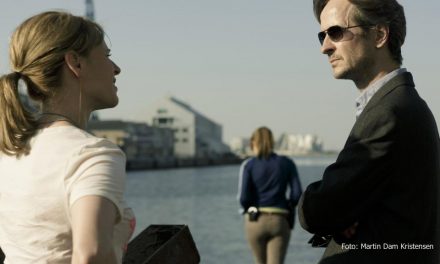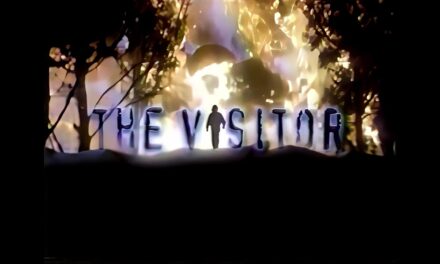Jason Jacobs and Stephen Peacock recently published a book on TV Aesthetics – Television Aesthetics and Style – in which they argue that discourses surrounding style and aesthetics are ‘curiously absent from many critical appraisals of contemporary television’ (2013: 1). They suggest that, instead, ‘academic work on television remains, for the most part, entrenched in theoretical frameworks’ (2). In this they echo Sarah Cardwell who, in the inaugural issue of Critical Studies in Television (1:1), acknowledged a need for more work on TV aesthetics, although she also recognised that this is a developing area within the discipline. Since the publication of Cardwell’s essay, the subject has become an increasingly significant, if still contested, area of television studies. A growing number of publications surrounding such programmes such as Angel, Buffy the Vampire Slayer, Dexter, Mad Men and Doctor Who (to name just a few) have begun to unpack the complexities of TV aesthetics. In fact, Critical Studies in Television has been a key source of publications that have focused a great deal of attention on aesthetics and I have recently guest edited an issue on Special Effects which quite consciously extends this work by examining an aspect of aesthetics that is too often ignored (forthcoming Autumn 2013 – apologies for the shameless self-promotion).
Jacobs and Peacock’s book is, therefore, a welcome addition to contemporary TV scholarship and it did get me thinking again about aesthetics, particularly in relation to TV horror. In our book TV Horror, Lorna Jowett and I sought to challenge the conception that horror is defined by its ability to graphically depict gore and violence by instead arguing that the genre, on TV and elsewhere, is defined by a stylistic excess. The aesthetics of horror are often characterised by a form of visual and aural spectacle, which on television often encompasses a combination of gore and stylistic experimentation, pushing the boundaries of acceptability and televisual transgression. One need go no further than the episode ‘Home’ (4:2) from The X-Files (worth mentioning here as The X-Files has just celebrated its 20th anniversary since coming on the air) to see an exemplary illustration of this tradition.

This is an episode that begins with a monstrous home birth, made horrifying and disturbing through the use of extreme close ups and expressionist lighting, in which glimpses of the filthy kitchen, deformed mother, rusty scissors cutting the umbilical cord, are accentuated by the sound of lightning mixed with horrifying screams and the crying of the new-born baby – soon to be buried alive. The events depicted are disturbing but the style makes it horror.
Later in the same episode, director Kim Manners juxtaposes the brutal murder of the town sheriff – Andy Tayler (a knowing reference to the Andy Griffith Show, 1960-1968) – and his wife with the dulcet tones of Johnny Mathis singing ‘Wonderful Wonderful’. I would challenge anyone familiar with this episode to listen to this music without feeling chills running down their spines. It is a stylistic choice that makes this scene so affective and memorable. TV horror is an excellent space in which to think about television aesthetics and for this I want to turn to an increasingly popular area of television programing, namely the serial killer genre.
This particular sub-genre of horror is, of course, a very appropriate starting point for a discussion of an ‘aesthetics of excess’, for the serial killer within popular culture is often presented as a master of mise-en-scène, obsessed with ritual, control and spectacle. Stories of the infamous real-life serial killer Ed Gein – the inspiration for Psycho (Alfred Hitchcock 1960), The Texas Chainsaw Massacre (Tobe Hooper 1974) and Silence of the Lambs (Jonathan Demme 1991) — focused less upon his victims and more upon his flair for making lampshades out of human skin. It is this detail, along with many others, that makes Gein’s story so memorable and haunting. It sets a scene for horror and presents the killer as in control of the mise-en-scène.
For instance, in Alfred Hitchcock’s Psycho, murderer Norman Bates not only murdered his mother and preserved her corpse, but he carefully positioned her in her chair by her bedroom window. To enhance the scene, he also dressed up like her, walking past the window for Marion Crane to see. This costuming also helped to accentuate his performance as Mrs Bates.

Similarly Mark in Michael Powell’s Peeping Tom (1960) not only films his victims as he kills them, but directs their performance of abject terror by holding up a mirror to their faces as they are skewered to death, ensuring he gets a suitably extreme reaction on film.

John Doe, in David Fincher’s Se7en, carefully lays out the crime scene of each of his seven deadly sin murders, reflecting his near-religious obsession with sin and leaving a series of subtle clues to lead the police investigators to the next victim. The story is told and the horror conveyed through this monstrous mise-en-scène.
Serial killers are now increasingly popular on television, particularly as a result of the rise of forensic procedurals like CSI (2000-), NCIS (2003-), and Bones (2005-), or psychological profiling series like Criminal Minds (2005-). Many of these shows have transformed the monster-of-the-week narrative convention into the serial-killer-of-the-week. Even the aforementioned The X-Files, despite its often science fiction leanings, featured its fair share of earth bound serial killers – staging scenes for Mulder and Scully to investigate (‘Grotesque’ 3:14; ‘Paper Hearts’ 4:10) and leading to its more sinister spin-off Millennium (1996-1999) which featured a weekly parade of killers to pursue through their meticulously constructed trail of breadcrumbs. Serial killers, according to film and television, don’t just want to kill but want to engage in a dialogue with their pursuers, leading them on a merry trail from body to body. This is, in fact, the entire premise for The Following (2013-), in which the FBI protagonist Ryan Hardy (Kevin Bacon) is always one step behind the Edgar Allan Poe inspired killer Joe Carroll (James Purefoy) and his followers.

The flaw with this premise is that for a series based upon a serial killer who inspires others to follow his calling, Joe Carroll is phenomenally uninspiring. Ok I admit my bias here – he is supposed to be an English Professor so inspiring that his students fall under his influence but the flashbacks to his lectures fall flat. I just don’t see him inspiring others to kill and to borrow from Dennis Quaid in the remake of D.O.A, he’s ‘an English Professor – we just don’t inspire that kind of passion!’. But that is neither here nor there.
Other shows, such as Dexter (2006-2013), Hannibal (2013-) and The Bates Motel (2013-) present us with far more engaging and troubling serial killers as they tackle with our fascination with this figure head on, by shifting the focus away from the investigators to the killers themselves. These series don’t just tell us that these characters are fascinating…they fascinate us.


This shift in point of view is significant as it provides the opportunity not only to see how these scenes are constructed but to see them from the point of view of the killer – as both a scene of horror and beauty. Here the aesthetics are crucial. Even The Bates Motel, a series that tells the back story of a nascent serial killer, privileges Norman’s perspective on scenes of crime as he flips through a book of drawings of violence and sexual sadism which he finds under the carpet in one of the motel rooms, and imagines the violence being enacted. He is both drawn to the violence and repelled by it – horrified by his mother’s murder of the man who raped her but also compelled to keep a memento of the event – the man’s belt. But at this point in the show (and I admit I still in the early stages of watching it), the focus is upon Norman’s damaged psyche and his desire for some semblance of normality rather than his control of the crime scene.
Dexter and Hannibal Lecter are well beyond that stage and have both accepted and revel in their place as serial killers and so do the shows’ aesthetics. Both are equally preoccupied with murder and with the staging of elaborate crime scenes that push the boundaries of acceptability for television while actually undermining notions of gore. While both series are often described as disturbing and graphic, they are generally not gory (which tends to require a high quota of blood spray). Compared to vampire series Being Human (2008-2013) and True Blood (2008-) , both of which often featured quite literally buckets of blood in the staging of their more violent scenes , Dexter and Hannibal are phenomenally restrained. And yet this restraint is all the more disturbing as it suggests a meticulous planning and obsessive control over the mise-en-scène. Here horror is conveyed through the construction and composition of the mise-en-scène, which usually revolves around the dismembered, modified or brutalised body, presented as art.
Simon Brown and I have written extensively on how Dexter presents murder as art and Dexter himself is presented to the audience as both artist and art critic, critiquing the work of others while seeking to emulate and improve upon the creations of those killers he admires – such as the Ice Truck Killer of season one and Trinity in season four (see our chapter ‘The Art of Sp(l)atter: Body Horror in Dexter’ in Douglas L. Howard’s Dexter: Investigating Cutting Edge Television). Hannibal seems like the obvious extension to this work, appearing on our television screens in the same year that Dexter has come to an end. It shares with Dexter its creative presentation of the murdered body, dismembered and presented as a spectacular form of macabre sculpture. While the Ice Truck Killer in season one of Dexter positioned body parts in disturbing recreations of Dexter’s family vacation photos,

the weekly crime scenes on Hannibal present the body in a broad array of increasingly unsettling mosaics:
the garden of fungal corpses,

the human cello,

the human totem pole,

the kneeling angels.

What distinguishes Hannibal from Dexter, and where the show is increasingly fascinating, is the clash of competing points of view, as the show is presented from the perspectives of both the investigator Will Graham and Hannibal – the yet to be revealed killer manipulating events from behind the scenes. While Hannibal renders murder – either through action or through influence – horrifically beautiful, Will restores the Gothic to the crime scene and the forensic investigation process. His method is defined by empathy rather than scientific analysis (something Dexter does through his analysis of blood spatter), as he imagines his way toward unlocking the mind of the killer. As a result the aesthetics privilege the dream-like and nightmarish in their visual and aural style, with Will imaging his way toward a solution.
Aesthetics in Hannibal therefore not only illicit feelings of wonder and horror within the show (the attraction/repulsion that Norman experiences in The Bates Motel), but they also serve as the battle ground between two masters of mise-en-scène, one constructing the scene for analysis and the other deconstructing it, peeling the elements of the scene away layer by layer in the search for meaning like a TV scholar unlocking the meaning of TV aesthetics itself. As such, Hannibal presents aesthetics within television as not only worthy of study but central to the series’ narrative and emotional affect. This is a show that is deserving of detailed close analysis of its horrific pleasures… so watch this space. Having now laid out the agenda, I will undoubtedly return for more.
Stacey Abbott is a Reader in Film and Television Studies at the University of Roehampton. She is the author of Celluloid Vampires (2007) and Angel: TV Milestone (2009), and co-author, with Lorna Jowett, of TV Horror: Investigating the Dark Side of the Small Screen (2013). She is also the editor of The Cult TV Book (2010) and General Editor of the Investigating Cult TV series at I.B. Tauris.





